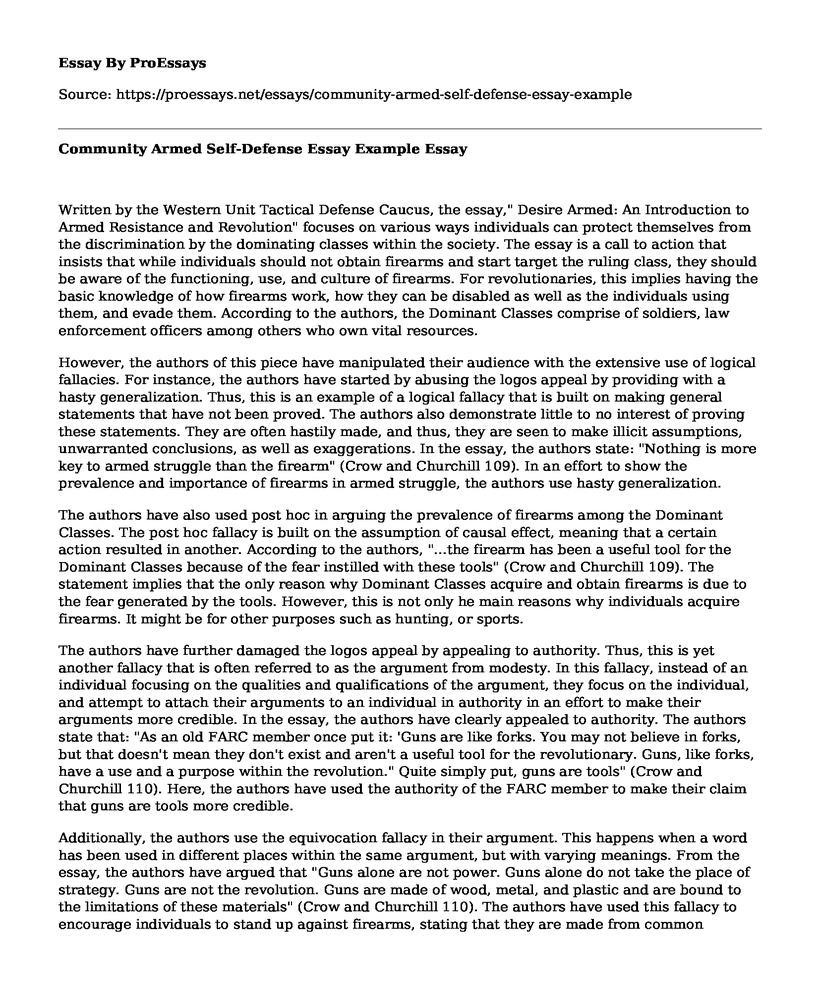Written by the Western Unit Tactical Defense Caucus, the essay," Desire Armed: An Introduction to Armed Resistance and Revolution" focuses on various ways individuals can protect themselves from the discrimination by the dominating classes within the society. The essay is a call to action that insists that while individuals should not obtain firearms and start target the ruling class, they should be aware of the functioning, use, and culture of firearms. For revolutionaries, this implies having the basic knowledge of how firearms work, how they can be disabled as well as the individuals using them, and evade them. According to the authors, the Dominant Classes comprise of soldiers, law enforcement officers among others who own vital resources.
However, the authors of this piece have manipulated their audience with the extensive use of logical fallacies. For instance, the authors have started by abusing the logos appeal by providing with a hasty generalization. Thus, this is an example of a logical fallacy that is built on making general statements that have not been proved. The authors also demonstrate little to no interest of proving these statements. They are often hastily made, and thus, they are seen to make illicit assumptions, unwarranted conclusions, as well as exaggerations. In the essay, the authors state: "Nothing is more key to armed struggle than the firearm" (Crow and Churchill 109). In an effort to show the prevalence and importance of firearms in armed struggle, the authors use hasty generalization.
The authors have also used post hoc in arguing the prevalence of firearms among the Dominant Classes. The post hoc fallacy is built on the assumption of causal effect, meaning that a certain action resulted in another. According to the authors, "...the firearm has been a useful tool for the Dominant Classes because of the fear instilled with these tools" (Crow and Churchill 109). The statement implies that the only reason why Dominant Classes acquire and obtain firearms is due to the fear generated by the tools. However, this is not only he main reasons why individuals acquire firearms. It might be for other purposes such as hunting, or sports.
The authors have further damaged the logos appeal by appealing to authority. Thus, this is yet another fallacy that is often referred to as the argument from modesty. In this fallacy, instead of an individual focusing on the qualities and qualifications of the argument, they focus on the individual, and attempt to attach their arguments to an individual in authority in an effort to make their arguments more credible. In the essay, the authors have clearly appealed to authority. The authors state that: "As an old FARC member once put it: 'Guns are like forks. You may not believe in forks, but that doesn't mean they don't exist and aren't a useful tool for the revolutionary. Guns, like forks, have a use and a purpose within the revolution." Quite simply put, guns are tools" (Crow and Churchill 110). Here, the authors have used the authority of the FARC member to make their claim that guns are tools more credible.
Additionally, the authors use the equivocation fallacy in their argument. This happens when a word has been used in different places within the same argument, but with varying meanings. From the essay, the authors have argued that "Guns alone are not power. Guns alone do not take the place of strategy. Guns are not the revolution. Guns are made of wood, metal, and plastic and are bound to the limitations of these materials" (Crow and Churchill 110). The authors have used this fallacy to encourage individuals to stand up against firearms, stating that they are made from common materials such as plastic, wood, and metal.
Finally, the straw man fallacy is also present in the essay. In an effort to promote the idea that an armed revolutionary wind posed no threats to individuals, the authors have used the straw man fallacy, further damaging their logos appeal. The straw man fallacy is built on the notion of providing with misrepresentations in an effort to make the arguments of others weaker and a less credible. The authors state that:
"The fact that the Black Panther Party was armed was not reason enough for it to be considered a threat. The real threat came from their development of a social movement based around free food programs, prisoner organizing, and community empowerment" (Crow and Churchill 110).
From the statement, the authors try to make the argument that armed revolutionary movements present threats weaker by stating that the actual threat was from social movements based on community empowerment, prisoner organizing, and free food programs.
Conclusion
The essay can be termed as a call to action, encouraging revolutionaries to stand up against firearms and the Dominant Classes through learning more about firearms. The authors insist that the essay does not openly challenge individuals to obtain firearms and target these groups. Rather, it encourages individuals to acquire more knowledge on the various ways guns function, how they can be disabled and how individuals can evade them. In persuading the audience, the authors, however, apply a variety of fallacies. In the essay, among the fallacies used include post hoc, hasty generalizations, appeal to authority, among others.
Works Cited
Crow, S., and W. Churchill. Setting sights: Histories and reflections on community armed self-defense. 2018.
Cite this page
Community Armed Self-Defense Essay Example. (2022, Aug 30). Retrieved from https://proessays.net/essays/community-armed-self-defense-essay-example
If you are the original author of this essay and no longer wish to have it published on the ProEssays website, please click below to request its removal:
- Examples of Human Rights Violations Around the World
- Crime Decline Genre Analysis
- Responses to Qestions on Euthanasia
- Research Paper on Criminal Procedure: Arrests, Conviction, Sentencing & Challenges
- Conflict Resolution Between Employees & Employers: Unions vs. Arbitration - Case Study
- Addiction - Research Paper Example
- Promoting Peace and Justice: An In-Depth Interview with Jeff Stack from Fellowship of Reconciliation USA







